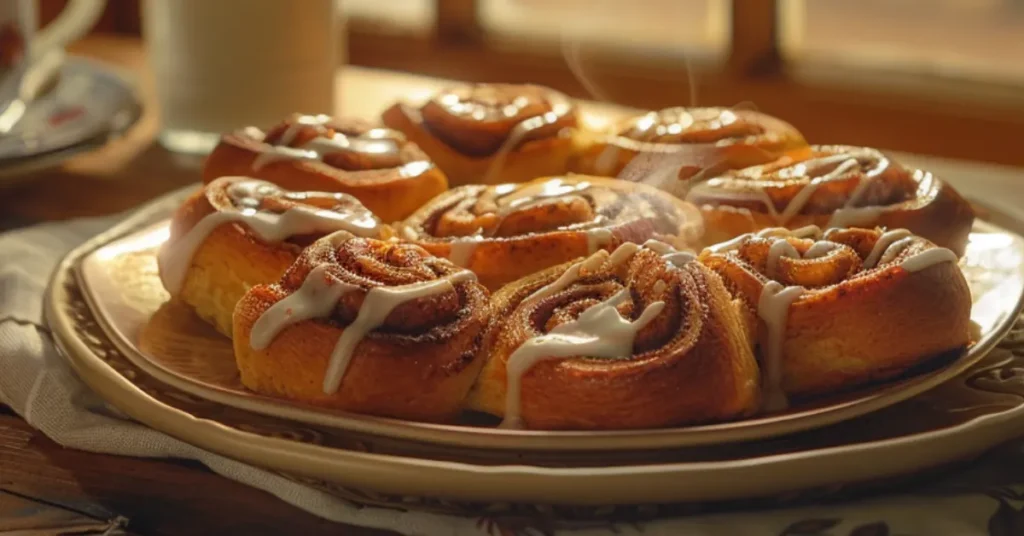Table of Contents
Sourdough discard cinnamon rolls combine the tangy complexity of sourdough with the sweet, comforting flavors of cinnamon and sugar, creating a delightful twist on a classic favorite. This article will guide you through everything you need to know to make these delicious treats, from the basics of sourdough discard to expert baking tips.
Introduction (sourdough discard cinnamon rolls)
Sourdough baking has seen a resurgence in popularity, with enthusiasts appreciating not just the taste but also the sustainability aspect of using every bit of their starter. Sourdough discard cinnamon rolls are a brilliant example of how this age-old technique can be repurposed into something both delicious and practical. They offer a unique flavor profile that sets them apart from traditional cinnamon rolls, making them a must-try for any baking aficionado.
What is Sourdough Discard?
Sourdough discard is the portion of your sourdough starter that is removed before feeding to keep the starter fresh and active. Instead of throwing it away, this discard can be used in a variety of recipes, adding a unique depth of flavor and slight tanginess that enhances baked goods, including cinnamon rolls.

More recipes: Knorr Vegetable Dip Recipe
The Unique Appeal of Sourdough Discard Cinnamon Rolls
These cinnamon rolls are not your average bakery treat. The sourdough discard adds a complexity of flavor that balances the sweetness of the cinnamon sugar filling, creating a moreish pastry that’s both tangy and sweet. This section will delve into what makes these cinnamon rolls a standout treat.
Benefits of Using Sourdough Discard
In the world of baking, sourdough discard represents a treasure trove of culinary potential, particularly when it comes to creating delectable treats like sourdough discard cinnamon rolls. This seemingly simple by-product of sourdough starter maintenance is not only versatile but also imbued with a host of benefits that extend beyond mere flavor enhancement. Let’s delve into the multifaceted advantages of using sourdough discard, shedding light on why it’s a beloved ingredient among baking enthusiasts.
1. Reducing Food Waste (sourdough discard cinnamon rolls)
One of the most immediate benefits of using sourdough discard is its contribution to reducing food waste. In the process of maintaining a sourdough starter, bakers often find themselves with an excess of starter that needs to be removed to keep the culture active and healthy. Instead of discarding this excess into the waste bin, repurposing it into recipes like cinnamon rolls turns what would be waste into a valuable ingredient, embodying a more sustainable and conscientious approach to baking.
2. Enhanced Flavor Profile (sourdough discard cinnamon rolls)
Sourdough discard adds a unique depth of flavor to baked goods that is hard to achieve with commercial yeast alone. Its slightly tangy, fermented notes can balance the sweetness of recipes, adding complexity and richness to the overall taste. This nuanced flavor enhancement makes sourdough discard cinnamon rolls not just a treat for the palate but also a gourmet experience.
3. Improved Texture (sourdough discard cinnamon rolls)
The natural fermentation process of sourdough discard can contribute to a better texture in baked goods. When used in cinnamon rolls, for example, it can help create a more tender crumb and a delightful chewiness that enhances the eating experience. The acidity in the discard can also break down gluten, making the dough easier to handle and resulting in a softer texture.
4. Nutritional Benefits (sourdough discard cinnamon rolls)
Sourdough discard can offer nutritional advantages over traditional baking methods. The fermentation process increases the availability of certain nutrients, such as B vitamins, and can make minerals more bioavailable by reducing phytic acid, an antinutrient. Additionally, the lactic acid bacteria present in sourdough discard can contribute to a healthier gut microbiome, adding a probiotic aspect to your baked treats.
5. Versatility in Baking (sourdough discard cinnamon rolls)
The beauty of sourdough discard lies in its versatility. It can be incorporated into a wide range of recipes, from sweet to savory. Whether you’re making cinnamon rolls, pancakes, waffles, or even crackers, sourdough discard can be adapted to suit various culinary creations, making it a staple ingredient for experimental and traditional bakers alike.
6. Longer Shelf Life (sourdough discard cinnamon rolls)
Baked goods made with sourdough discard often enjoy a longer shelf life compared to those made with commercial yeast. The acidic environment created by the sourdough can act as a natural preservative, slowing down the staling process and keeping your cinnamon rolls fresher for longer. This means you can savor your baking efforts over several days, reducing the need for frequent baking.
7. Economic Efficiency (sourdough discard cinnamon rolls)
For those who maintain a sourdough starter, using the discard in baking is also an economically efficient practice. Instead of purchasing additional ingredients like commercial yeast, bakers can leverage their sourdough discard, maximizing the use of their starter and minimizing the need for other leavening agents. This not only saves money but also encourages a more self-sufficient approach to baking.
Step-by-Step Guide to Making Sourdough Discard Cinnamon Rolls
Transforming sourdough discard into delectable cinnamon rolls is a rewarding baking project that combines the tangy complexity of sourdough with the sweet, comforting flavors of cinnamon and sugar. This step-by-step guide will walk you through the process of making sourdough discard cinnamon rolls, ensuring you achieve soft, flavorful, and irresistible pastries every time.
Ingredients Preparation
Before you begin, ensure all your ingredients are measured and ready. This includes warming the milk slightly (it should be just warm to the touch, not hot), bringing the eggs and butter to room temperature, and measuring out your sourdough discard, flour, sugar, cinnamon, and other ingredients as listed in the “Essential Ingredients” section.
1. Mixing the Dough
- Start with the Wet Ingredients: In a large mixing bowl, whisk together the sourdough discard, warm milk, melted butter (make sure it’s cooled slightly so it doesn’t cook the eggs), eggs, and vanilla extract until well combined.
- Add the Dry Ingredients: To the wet mixture, add the flour, sugar, and salt. Using a wooden spoon or a stand mixer fitted with a dough hook, mix until a rough dough forms.
2. Kneading the Dough
- Knead the Dough: If using a stand mixer, continue to knead with the dough hook on a medium-low setting for about 5 to 7 minutes. If kneading by hand, turn the dough out onto a lightly floured surface and knead for about 8 to 10 minutes, until the dough is smooth, elastic, and slightly tacky but not sticky.
- First Rise: Place the kneaded dough in a lightly greased bowl, cover with a damp cloth or plastic wrap, and let it rise in a warm, draft-free place until doubled in size, about 1 to 2 hours depending on the activity of your sourdough discard and the temperature of your kitchen.
3. Preparing the Filling
- While the dough is rising, mix together the softened butter, brown sugar, and cinnamon until you have a spreadable paste. This will be spread over the rolled-out dough to create the cinnamon-sugar layer inside the rolls.
4. Shaping the Rolls
- Roll Out the Dough: Once the dough has doubled in size, punch it down gently and turn it out onto a lightly floured surface. Roll the dough into a large rectangle, about ¼ inch thick.
- Apply the Filling: Spread the cinnamon-sugar-butter mixture evenly over the rolled-out dough, leaving a small margin around the edges.
- Roll Up the Dough: Starting with the long edge closest to you, roll the dough into a tight log. Seal the seam by pinching the dough together at the end.
- Cut the Rolls: Using a sharp knife or a piece of dental floss, cut the log into 12 equal pieces. Dental floss can help achieve cleaner cuts by sliding it under the log, crossing the ends over the top, and pulling tight to slice through the dough.
5. Second Rise
- Arrange the Rolls: Place the cut rolls in a greased baking dish or pan, leaving some space between them for expansion. Cover them with a damp cloth or plastic wrap and let them rise again until nearly doubled in size, about 30 minutes to 1 hour.
- Preheat the Oven: During the last 20 minutes of the second rise, preheat your oven to 350°F (175°C).
6. Baking
- Bake the Rolls: Bake the cinnamon rolls in the preheated oven for 25 to 30 minutes, or until they are golden brown and the filling is bubbly.
- Cooling: Allow the rolls to cool in the pan for about 10 minutes before drizzling with icing or serving.
7. Preparing the Icing
- While the rolls are cooling, mix powdered sugar with a small amount of milk or cream and vanilla extract to create a thick but pourable icing. Adjust the consistency with more milk or powdered sugar as needed.
8. Finishing Touches
- Drizzle the Icing: Drizzle the prepared icing over the warm cinnamon rolls, allowing it to seep into the rolls and set slightly before serving.
Proofing and Baking Tips for Perfect Sourdough Discard Cinnamon Rolls
Achieving the perfect cinnamon rolls, especially when incorporating sourdough discard, involves mastering the art of proofing and baking. These processes are crucial for developing the right texture and flavor, ensuring your rolls are soft, fluffy, and deliciously golden. Here are expert tips to guide you through proofing and baking your sourdough discard cinnamon rolls to perfection.
Proofing Tips (sourdough discard cinnamon rolls)
1. Ideal Temperature for Proofing
- The optimal temperature for proofing dough is between 75°F and 78°F (24°C to 26°C). If your kitchen is cooler, you can proof the dough in a slightly warmed oven (turned off after preheating for a minute or two) or on top of a refrigerator where it’s slightly warmer. The warmth helps the yeast in the sourdough discard to become more active, aiding in the dough’s rise.
2. Avoid Over-Proofing
- Over-proofing occurs when the dough has risen too much, which can lead to rolls that collapse during or after baking. To test if your dough is proofed just right, gently press a finger into it. If the indentation slowly springs back halfway, it’s ready to bake. If the dough springs back immediately, it needs more time; if the indentation stays, it’s over-proofed.
3. Consistency is Key
- Ensure that all your rolls are the same size for even proofing and baking. Uneven sizes can lead to some rolls being over or under-baked. Using a ruler when cutting your rolls can help achieve uniformity.
Baking Tips (sourdough discard cinnamon rolls)
1. Preheat Your Oven
- Always preheat your oven to the correct temperature before baking. An oven thermometer can help ensure accuracy, as some ovens can be off by quite a bit. This step is crucial for achieving the perfect bake.
2. Middle Rack Position
- Bake your cinnamon rolls on the middle rack of your oven to promote even heat distribution. If you’re baking multiple pans at once, rotate them halfway through the baking time to ensure even browning.
3. Don’t Over-Bake
- Over-baked cinnamon rolls can become hard and dry. Start checking your rolls a few minutes before the recipe’s suggested baking time is up. They should be golden brown on top and sound hollow when tapped. An instant-read thermometer inserted into the center (avoiding the filling) should read around 190°F (88°C) when they’re done.
4. Use a Light-Colored Baking Pan
- Dark pans can absorb more heat, leading to the bottoms of the rolls cooking faster than the rest. A light-colored or glass baking dish helps in achieving an even bake.
5. Cooling Time
- Allow the cinnamon rolls to cool in the pan for about 10 minutes after baking. This brief cooling period helps the rolls set without becoming soggy. However, don’t leave them in the pan too long, as the sugar in the filling can harden, making them difficult to remove.
Additional Tips (sourdough discard cinnamon rolls)
1. Steam for Softness
- For extra soft rolls, place a small pan of water on the bottom rack of the oven during baking. The steam helps keep the rolls moist and prevents a hard crust from forming.
2. Brush with Butter
- Brushing the tops of the rolls with melted butter right after they come out of the oven can add flavor and softness to the crust, enhancing the overall taste and texture.
By following these proofing and baking tips, you can ensure your sourdough discard cinnamon rolls come out perfectly every time. Remember, baking is as much an art as it is a science, so don’t be afraid to adjust based on your oven’s idiosyncrasies and your personal preferences. Happy baking!
Common Mistakes to Avoid When Making Sourdough Discard Cinnamon Rolls
Sourdough discard cinnamon rolls are a delightful treat that combines the tangy flavor of sourdough with the sweet, comforting essence of cinnamon rolls. However, achieving the perfect batch can sometimes be tricky, especially for those new to working with sourdough discard. Here are some common mistakes to avoid, ensuring your cinnamon rolls turn out soft, fluffy, and delicious every time.
1. Not Allowing the Dough to Proof Enough
One of the key steps in making any sourdough-based baked good is allowing the dough to proof properly. With sourdough discard cinnamon rolls, it’s crucial to give the dough enough time to rise, both during the first proof and after shaping the rolls. Sourdough can take longer to rise than dough made with commercial yeast, especially if your kitchen is on the cooler side. Rushing this process can result in dense, heavy rolls that lack the desired light and airy texture.
2. Over-Proofing the Dough
Conversely, over-proofing the dough is just as detrimental. If the dough rises too much, it can lead to over-expanded rolls that collapse either in the oven or as soon as they’re taken out, resulting in flat, dense rolls. To avoid this, perform the finger dent test: gently press a finger into the dough; if the indentation fills back slowly, it’s ready; if it stays, the dough has over-proofed.
3. Using Old Sourdough Discard
While using sourdough discard is a fantastic way to reduce waste, it’s important to use discard that’s still active. Very old discard that has been sitting in the fridge for weeks without feeding might not have enough yeast activity left to contribute to the rise of the dough. Ideally, use discard that’s no more than a week old for the best results.
4. Incorrect Oven Temperature
Baking at the wrong temperature can ruin your cinnamon rolls. An oven that’s too hot can cause the outside to burn before the inside is fully baked, while an oven that’s too cool can result in undercooked rolls. Use an oven thermometer to ensure your oven is at the correct temperature, as internal oven thermostats can often be inaccurate.
5. Not Rolling the Dough Tightly Enough
When shaping your cinnamon rolls, it’s important to roll the dough tightly. A loose roll can cause the layers to separate, leading to unappealing gaps in your baked rolls. Additionally, make sure to seal the edge of the dough after rolling to keep the roll from unraveling during the rise and bake.
6. Skimping on the Filling
The filling is what gives cinnamon rolls their signature flavor and gooey texture. Skimping on the cinnamon-sugar-butter mixture can result in rolls that are lacking in flavor and moisture. Be generous with the filling, spreading it evenly all the way to the edges of the dough.
7. Cutting the Rolls Improperly
Using a dull knife to cut the rolls can squish the dough, affecting the final shape and rise of your cinnamon rolls. For clean cuts, use a very sharp knife, dental floss, or a thin piece of thread. These tools allow you to cut the rolls without compressing the dough, ensuring they retain their shape during proofing and baking.
8. Forgetting the Second Rise
After shaping the rolls and placing them in the baking dish, they need to go through a second rise. This step is crucial for developing the final texture and size of the rolls. Skipping this step or cutting it short can lead to dense rolls that don’t have that characteristic soft, fluffy texture.
By avoiding these common mistakes, you’ll be well on your way to creating sourdough discard cinnamon rolls that are not only delicious but also showcase the unique flavors and textures that sourdough brings to baked goods. Remember, baking is a learning process, and each batch is an opportunity to refine your skills and techniques.
FAQs (sourdough discard cinnamon rolls)
Can I use old sourdough discard for cinnamon rolls?
It’s best to use discard that’s no more than a week old to ensure enough yeast activity for the dough to rise.
How do I know if my dough is over-proofed?
Perform the finger dent test: if the indentation stays, the dough is over-proofed.
What’s the ideal proofing temperature for sourdough cinnamon rolls?
Between 75°F and 78°F (24°C to 26°C) is optimal for sourdough proofing.
Can I make these cinnamon rolls vegan?
Yes, substitute plant-based milk, vegan butter, and use a flax egg or commercial egg replacer.
How can I ensure my cinnamon rolls are fluffy and soft?
Proper proofing, not overworking the dough, and baking at the correct temperature are key.
Why did my cinnamon rolls turn out hard?
Over-baking, over-kneading, or using too much flour can lead to hard rolls.




